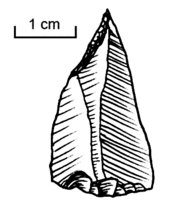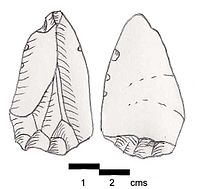Emiran
| Geographical range | Levant, Arabia |
|---|---|
| Period | Upper Paleolithic |
| Dates | about 60,000–40,000 cal B.P.[1][2] |
| Preceded by | Mousterian, Aterian |
| Followed by | Bohunician, Ahmarian, Levantine Aurignacian |

| The Paleolithic |
|---|
| ↑ Pliocene (before Homo) |
| ↓ Mesolithic |
Emiran culture was a culture that existed in the Levant (Lebanon, Palestine, Syria, Israel, Jordan and Arabia) between the Middle Paleolithic and the Upper Paleolithic periods. It is the oldest known of the Upper Paleolithic cultures and remains an enigma as it transitionally has no clear African progenitor.[3] This has led some scholars to conclude that the Emiran is indigenous to the Levant.[4] However, some argue that it reflects broader technological trends observed earlier in North Africa, at older sites like Taramsa 1 in Egypt, "which contains modern human remains dated to 75,000 years ago".[5]
Emiran period
[edit]Emiran culture may have developed from the local Mousterian without rupture, keeping numerous elements of the Levalloise-Mousterian, together with the locally typical Emireh point. The Emireh point is the type tool of stage one of the Upper Paleolithic, first identified in the Emiran culture.[6] Numerous stone blade tools were used, including curved knives similar to those found in the Châtelperronian culture of Western Europe.
The Emiran eventually evolved into the Ahmarian, and later the Levantine Aurignacian culture (formerly called Antelian), still of Levalloise tradition but with some Aurignacian influences.[7]
According to Dorothy Garrod, the Emireh point, known from several sites in Palestine, is the hallmark of this culture.[8]
Relationships
[edit]"Levantine Aurignacian", from the Levant, is a type of blade technology very similar to the European Aurignacian, following chronologically the Emiran and Early Ahmarian in the same area of the Near East, and closely related to them.[9]
-
Emireh point microlith
-
Emireh point.
See also
[edit]References
[edit]- ^ Rose, Jeffrey I.; Marks, Anthony E. (2014). ""Out of Arabia" and the Middle-Upper Palaeolithic transition in the Southern Levant". Quartär. 61: 49–85. doi:10.7485/qu61_03.
- ^ Bosch, Marjolein D. (April 30, 2015). "New chronology for Ksâr 'Akil (Lebanon) supports Levantine route of modern human dispersal into Europe". Proceedings of the National Academy of Sciences of the United States of America. 112 (25): 7683–7688. Bibcode:2015PNAS..112.7683B. doi:10.1073/pnas.1501529112. PMC 4485136. PMID 26034284.
- ^ Marks, Anthony; Rose, Jeff. "Through a prism of paradigms: a century of research into the origins of the Upper Palaeolithic in the Levant". In "Modes de contacts et de déplacements au Paléolithique Eurasiatique" – via www.academia.edu.
- ^ Douka, Katerina (2013). "Exploring "the great wilderness of prehistory": The chronology of the Middle to the Upper Palaeolithic transition in the northern Levant". Mitteilungen der Gesellschaft für Urgeschichte. 22: 11–40 – via www.academia.edu.
- ^ Hoffecker, John (2009). "The spread of modern humans in Europe". PNAS. 106 (38): 16040–16045. doi:10.1073/pnas.0903446106. PMC 2752585. PMID 19571003.
- ^ Lorraine Copeland; P. Wescombe (1965). Inventory of Stone-Age sites in Lebanon, p. 48 & Figure IV, 4, p. 150. Imprimerie Catholique. Retrieved 21 July 2011.[permanent dead link]
- ^ Shea, John J. (2013). Stone Tools in the Paleolithic and Neolithic Near East: A Guide. Cambridge University Press. p. 154. ISBN 9781107006980.
- ^ Binford, Sally R.; Binford, Lewis Roberts. Archeology in Cultural Systems. Transaction Publishers. ISBN 9780202364209 – via Google Books.
- ^ Shea, John J. (2013). Stone Tools in the Paleolithic and Neolithic Near East: A Guide. Cambridge University Press. pp. 150–155. ISBN 9781107006980.
Further reading
[edit]- M. H. Alimen and M. J. Steve, Historia Universal siglo XXI. Prehistoria. Siglo XXI Editores, 1970 (reviewed and corrected in 1994) (original German edition, 1966, titled Vorgeschichte). ISBN 84-323-0034-9



